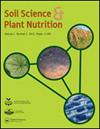Enhancement of alkali- and oxidation-modified biochars derived from water hyacinth for ammonium adsorption capacity
IF 1.8
4区 农林科学
Q3 ENVIRONMENTAL SCIENCES
引用次数: 0
Abstract
ABSTRACTWastewater containing high concentrations of ammonium-nitrogen (NH4+-N) is considered a major concern because its untreated discharge has a variety of adverse effects on the environment and human health. Adsorption using biochars is an easy and cost-effective wastewater treatment method. However, aquatic plants such as water hyacinth for biochar feedstock are considered unsuitable for adsorbent use due to limited NH4+-N adsorption capacity. In this study, biochar made from water hyacinth was modified with potassium hydroxide (KOH) and hydrogen peroxide (H2O2) to obtain highly efficient adsorbent. This study aimed to enhance NH4+-N adsorption capacity by KOH- and H2O2-treatments and identify NH4+-N adsorption mechanism of the modified biochars derived from water hyacinth. The NH4+-N adsorption of all biochars was dependent on the initial solution pH increasing from pH 2 to 4, then relatively constant from pH 4 to 8. Pseudo-second-order model and Langmuir model were found to be the best fit for NH4+-N adsorption data. The maximum NH4+-N adsorption capacity of biochars increased about 8 times (17.1 mg g−1) and 10 times (21.5 mg g−1) after KOH- and H2O2-modification, respectively, compared to pristine biochar (2.14 mg g−1). The main NH4+-N adsorption mechanisms were suggested as cation exchange for both biochars particularly KOH-modified biochar, and hydrogen bonding by oxygen-containing surface functional groups for H2O2-modified biochar. This study suggested that aquatic plant-based biochar, which has been considered difficult to use, had potential as a promising alternative adsorbent for removing NH4+-N from wastewater through modification.KEY WORDS: Adsorption isothermadsorption kineticscarboxylic groupcation exchange capacityFTIR Disclosure statementNo potential conflict of interest was reported by the author(s).Additional informationFundingThe work was supported by the Science and Technology Research Partnership for Sustainable Development [JPMJSA2005].水葫芦碱改性和氧化改性生物炭对铵的吸附能力增强
含高浓度氨氮(NH4+-N)的废水被认为是一个主要问题,因为其未经处理的排放对环境和人类健康有各种不利影响。生物炭吸附是一种简单、经济的污水处理方法。然而,作为生物炭原料的水葫芦等水生植物由于其对NH4+-N的吸附能力有限,被认为不适合作为吸附剂使用。以水葫芦为原料,利用氢氧化钾(KOH)和过氧化氢(H2O2)对生物炭进行改性,得到高效吸附剂。本研究旨在通过KOH-和h2o2 -处理提高水葫芦生物炭对NH4+- n的吸附能力,并探讨水葫芦改性生物炭对NH4+- n的吸附机理。所有生物炭对NH4+-N的吸附都依赖于初始溶液pH从pH 2增加到4,然后从pH 4增加到8相对稳定。拟二阶模型和Langmuir模型最适合NH4+-N吸附数据。生物炭对NH4+- n的最大吸附量分别比原始生物炭(2.14 mg g - 1)提高了约8倍(17.1 mg g - 1)和10倍(21.5 mg g - 1)。NH4+-N的吸附机制主要为阳离子交换机制,特别是koh改性的生物炭;h2改性的生物炭表面含氧官能团的氢键作用。该研究表明,水生植物生物炭具有通过改性去除废水中NH4+-N的潜力。关键词:吸附等温吸附动力学羧基交换容量红外光谱披露声明作者未报告潜在利益冲突。本研究得到了可持续发展科学技术研究伙伴关系[JPMJSA2005]的支持。
本文章由计算机程序翻译,如有差异,请以英文原文为准。
求助全文
约1分钟内获得全文
求助全文
来源期刊

Soil Science and Plant Nutrition
农林科学-农艺学
CiteScore
4.80
自引率
15.00%
发文量
56
审稿时长
18-36 weeks
期刊介绍:
Soil Science and Plant Nutrition is the official English journal of the Japanese Society of Soil Science and Plant Nutrition (JSSSPN), and publishes original research and reviews in soil physics, chemistry and mineralogy; soil biology; plant nutrition; soil genesis, classification and survey; soil fertility; fertilizers and soil amendments; environment; socio cultural soil science. The Journal publishes full length papers, short papers, and reviews.
 求助内容:
求助内容: 应助结果提醒方式:
应助结果提醒方式:


